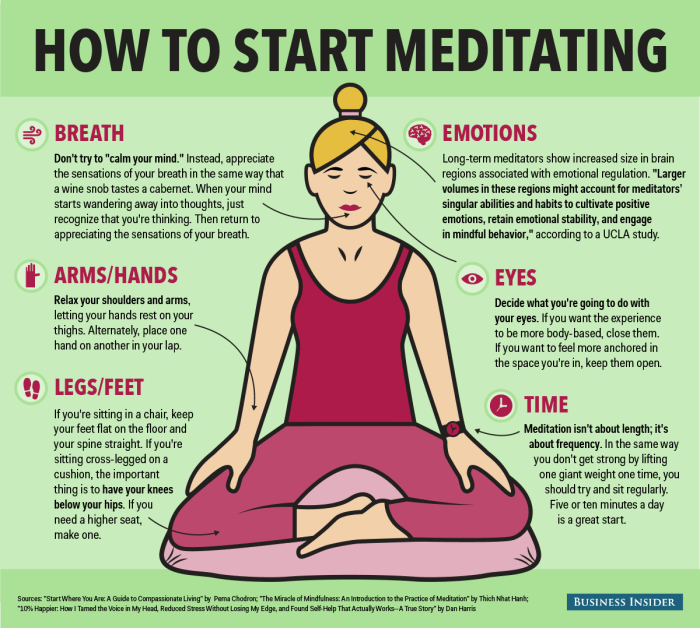Starting with 10 Techniques for Enhancing Mindfulness During Meditation, embark on a journey to unlock the secrets of tranquility and self-awareness.
Discover the power of mindfulness in meditation as we delve into specific techniques and practices to deepen your spiritual connection and enhance your overall well-being.
Understanding Mindfulness in Meditation
In the practice of meditation, mindfulness refers to the state of being fully present and aware of the current moment without judgment. It involves focusing on your breath, bodily sensations, thoughts, and emotions as they arise, without getting caught up in them.
Importance of Mindfulness During Meditation
- Mindfulness helps to cultivate a sense of calmness and clarity in the mind, allowing you to let go of distractions and worries.
- It enables you to observe your thoughts and emotions without reacting impulsively, promoting self-awareness and emotional regulation.
- By staying present in the moment, mindfulness can deepen your meditation practice and enhance the overall experience.
Examples of How Mindfulness Enhances the Meditation Experience
- When you practice mindfulness during meditation, you may notice a greater sense of peace and relaxation in both your mind and body.
- Being mindful helps you to stay focused and attentive, allowing you to immerse yourself fully in the present moment.
- Through mindfulness, you can develop a deeper connection with yourself and gain insights into your inner thoughts and emotions.
Breathing Techniques for Mindfulness: 10 Techniques For Enhancing Mindfulness During Meditation
Breathing techniques play a crucial role in enhancing mindfulness during meditation. By focusing on the breath, we can anchor our awareness to the present moment and cultivate a sense of calm and clarity.
Deep Breathing, 10 Techniques for Enhancing Mindfulness During Meditation
Deep breathing involves taking slow, deliberate breaths, filling your lungs with air and then exhaling fully. This technique helps relax the body and calm the mind, allowing you to be more present in the moment. To incorporate deep breathing into your meditation practice, follow these steps:
- Find a comfortable seated position.
- Close your eyes and take a few natural breaths to center yourself.
- Inhale deeply through your nose, expanding your belly, then your chest.
- Exhale slowly through your mouth, emptying your lungs completely.
- Repeat this cycle for several minutes, focusing on the sensation of your breath.
Box Breathing
Box breathing involves breathing in for a count, holding the breath, breathing out, and then holding the breath again, all for the same count. This technique helps regulate the breath and promote relaxation. To practice box breathing during meditation, follow these steps:
- Sit comfortably with your back straight and your hands resting on your knees.
- Inhale deeply for a count of four seconds.
- Hold your breath for four seconds.
- Exhale slowly for four seconds.
- Hold your breath again for four seconds.
- Repeat this cycle for several minutes, focusing on the rhythmic pattern of your breath.
Body Scan Method

The body scan method is a mindfulness meditation technique where you focus your attention on different parts of your body, moving from one area to another systematically. This practice involves bringing awareness to physical sensations, tension, or discomfort in each body part without judgment.
Benefits of Incorporating Body Scan into Your Meditation Practice
- Helps in deepening the mind-body connection
- Increases body awareness and sensitivity to physical sensations
- Promotes relaxation and releases tension in the body
- Aids in identifying areas of stress or discomfort for targeted relaxation techniques
- Enhances overall mindfulness and present moment awareness
Personal Experiences or Challenges Encountered
During my practice of the body scan method, I have encountered challenges in maintaining focus and concentration, especially when distractions arise. It can also be difficult to stay present and not get carried away by thoughts or emotions while scanning through the body. However, with consistent practice and patience, I have found that the body scan method has helped me become more in tune with my body and cultivate a sense of calm and relaxation.
Guided Visualization

Guided visualization is a mindfulness technique that involves mentally picturing a peaceful scene or scenario to enhance focus and relaxation during meditation. This method helps in reducing stress, anxiety, and promoting a sense of calmness and presence in the moment.
Examples of Visualizations
- Imagining a serene beach with gentle waves and warm sunlight.
- Visualizing a lush forest with birds chirping and a gentle breeze rustling the leaves.
- Picturing a peaceful mountain top with clear skies and a panoramic view.
Deepening the Meditative Experience
Guided visualization can deepen the meditative experience by engaging multiple senses and creating a vivid mental image. This technique allows the mind to focus on positive and calming visuals, redirecting attention from distracting thoughts. By immersing oneself in the visualization, practitioners can enhance mindfulness, relaxation, and overall well-being.
Incorporating Nature Sounds

Nature sounds can be a powerful tool to enhance mindfulness during meditation. The soothing sounds of nature can help create a calm and peaceful environment, allowing you to deepen your practice and focus on the present moment.
Specific Natural Sounds for Mindfulness
- The gentle rustling of leaves in the wind
- The rhythmic crashing of ocean waves
- The chirping of birds in the distance
- The soft patter of raindrops on leaves
- The steady flow of a river or stream
Impact of Nature Sounds on Concentration and Relaxation
Research has shown that exposure to nature sounds can reduce stress, improve mood, and increase feelings of relaxation. The calming effect of these sounds can help quiet the mind and enhance concentration during meditation.
Mindful Movement Practices
Practicing mindful movement, such as yoga or tai chi, can be a powerful way to enhance mindfulness during meditation. These practices involve a combination of gentle physical movements, breath work, and focused attention, which can help quiet the mind and bring a sense of presence to the present moment.
Benefits of Mindful Movement
- Improves body awareness and mindfulness
- Enhances focus and concentration
- Promotes relaxation and stress reduction
- Increases flexibility and strength
Tips for Integrating Mindful Movement
- Start with simple movements to connect with your body and breath
- Focus on the sensations in your body as you move
- Practice in a quiet, distraction-free space
- Combine mindful movement with traditional seated meditation for a well-rounded practice
Mindful Eating Meditation
Mindful eating is the practice of bringing full attention and awareness to the experience of eating, allowing you to engage with your food in a more conscious way. This practice is deeply connected to mindfulness meditation, as it encourages you to be present in the moment and fully experience the sensations, tastes, and textures of the food you are consuming.
Benefits of Practicing Mindful Eating During Meditation
- Enhances the enjoyment and appreciation of food
- Promotes healthier eating habits and portion control
- Increases awareness of hunger and fullness cues
- Helps in developing a more positive relationship with food
- Reduces mindless or emotional eating
Guidance on Engaging in Mindful Eating Meditation
- Start by taking a few deep breaths to center yourself and bring your focus to the present moment.
- Observe the appearance, smell, and texture of the food in front of you without judgment.
- Take small bites and chew slowly, savoring each mouthful and paying attention to the flavors.
- Notice the sensations of hunger and fullness as you eat, and listen to your body’s signals.
- Avoid distractions such as watching TV or using your phone while eating, and instead focus on the experience of eating.
Overcoming Distractions

When practicing mindfulness during meditation, it’s common to encounter distractions that can pull your focus away from the present moment. Overcoming these distractions is crucial for deepening your meditation practice and experiencing the full benefits of mindfulness.
Identifying Common Distractions
- Physical discomfort, such as an itch or pain
- Thoughts about the past or future
- Noises or external distractions
- Emotional reactions or feelings
Strategies for Maintaining Focus
- Bring your attention back to your breath whenever you notice a distraction.
- Label distractions as “thinking” or “feeling” without judgment, then gently return to the present moment.
- Use a mantra or affirmations to anchor your focus and prevent wandering thoughts.
- Practice self-compassion and patience when distractions arise, accepting them as a natural part of the meditation process.
The Importance of Acknowledging Distractions
By acknowledging distractions without judgment, you cultivate a sense of awareness and non-reactivity, enhancing your ability to stay present and centered during meditation.
Setting Intentions

Setting intentions before meditation is a crucial step in enhancing mindfulness practice. It helps focus the mind, clarify goals, and create a sense of purpose for the meditation session. By setting intentions, individuals can cultivate a deeper connection to their practice and increase self-awareness.
Significance of Setting Intentions
Setting intentions allows individuals to bring awareness to their thoughts, emotions, and sensations during meditation. It helps in directing energy towards specific areas of growth or healing, creating a more meaningful and transformative experience. By setting clear intentions, practitioners can align their actions with their values and aspirations, fostering a sense of purpose and fulfillment.
- One example of an intention for mindfulness meditation is to cultivate gratitude and appreciation for the present moment.
- Another intention could be to practice self-compassion and kindness towards oneself and others.
- Setting an intention to let go of negative thoughts or emotions can help in promoting mental clarity and emotional balance.
Personal Experiences
Setting intentions has greatly impacted my meditation sessions by providing a sense of direction and focus. For instance, when I set an intention to cultivate patience and understanding, I noticed a significant shift in my ability to stay present and calm during challenging moments. This intention guided my practice and allowed me to approach difficult situations with more compassion and resilience.
Overall, setting intentions has deepened my mindfulness practice and enriched my overall well-being.
Cultivating Gratitude
Gratitude plays a significant role in mindfulness meditation as it helps shift the focus from what is lacking to what is present. Cultivating gratitude can deepen the meditative experience by fostering a sense of contentment and appreciation for the present moment.
Practices for Cultivating Gratitude
- Start your meditation practice by reflecting on three things you are grateful for. This can be something as simple as a beautiful sunrise or a kind gesture from a friend.
- Use a gratitude journal to write down things you are thankful for each day. This practice can help you notice and appreciate the positive aspects of your life.
- Express gratitude towards yourself by acknowledging your efforts and strengths. This self-compassion can enhance your overall sense of well-being during meditation.
- Practice loving-kindness meditation by sending thoughts of gratitude and kindness to yourself, loved ones, and even those you may have difficulties with. This practice can cultivate a sense of interconnectedness and gratitude.
Final Wrap-Up
As we conclude our exploration of these 10 techniques, remember that mindfulness during meditation is not just a practice, but a way of life that can lead to profound transformation and inner harmony.